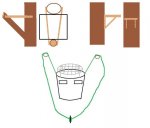he thought it may be Nitrogen fixing bacteria, but, didn't really find a match there either, so , I have no clue, just hoping its not bad for me...or the plant....
No way, it's definitely not this as you're not growing clover, peas, broad beans or other leguminous plants. It's hard to say without seeing it properly tbh.
HIDs are cheaper than fluorescents, since they're more efficient. Even a 100W HPS will piss all over a 150W fluorescent.
A metal halide will always produce less heat than a fluorescent light or CFL watt for watt. It's a common misconception that fluorescents are cooler watt for watt. They usually use less power, giving the illusion of producing less heat when you compare it to high wattage MH or HPS lamps commonly in use.
That said, you must replace MH and HPS bulbs at least every second grow, as they become less efficient over time, and might give the impression to some that the technology is only as good or worse than fluoros.
Question about humidity. What is the ideal humidity (percentage wise). Currently mine runs between 40 and 50 %
Question about leaf tips curled under... my plants are very healthy and green. A "few" of the fan leaves on the bottom of "some" plants have tips curled under... is this normal? I am currently just watering, have not started feeding yet. The temp and light is ideal. Any info?
The ideal RH depends on the temperature, leaf temperature etc. If you want a really accurate answer, you'll need to buy an infrared thermometer gun (the type you can buy in electronic stores quite cheaply these days which you aim at an object and it gives you an instant temp reading) and calculate the 'vapor pressure deficit' using tables you can find online. I enjoy doing this, and it's a method employed by serious multibillion dollar greenhouse businesses in Holland who grow tomatoes, chillis etc. It's easier than it sounds and will improve your yield over the long term compared to a haphazard approach most people use. You control the RH once you know the target range using a dehumidifier or a humidifier. An evaporative humidifier can increase the RH cheaply up until a certain point, depending on wet and dry thermometer readings. The best way to measure RH is with about 5 digital thermometers/hygrometers, taking an average of the 5 readings. Sling psychrometers are usually not as accurate as digital hygrometer technology these days, fortunately.
However, roughly speaking in veg the ideal RH is from 50-70% and in flower, 30-50%. The only reason lower RH is better in flower is because it can prevent botrytis mold from taking hold; it does not improve growth. Plants generally grow better in high humidity environments, even if in some instances it can increase the chances of mold taking hold.
....
Lotus Bloom, I love your setup. Must have been expensive (I don't know how much it cost in pounds, but I see it must have cost a load). If you don't mind me asking, are you growing just for yourself and your partner, or are you supplying a collective of patients?















 how old is she?
how old is she?